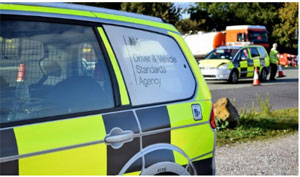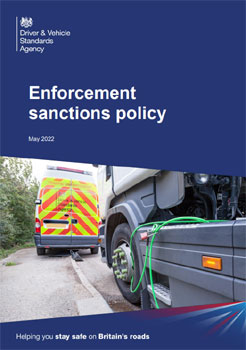
All of us have an interest in whether traffic law is appropriate, and whether it’s enforcement is carried out appropriately. Everyone uses the roads, and most of us use them in a variety of ways – as drivers, passengers, pedestrians or cyclists. We need a legal framework, which allows all road users to coexist safely and efficiently, and gives appropriate weight to the desire of users of motorised transport to reach their destination quickly and efficiently, while safeguarding the interests of other road users.
As far as HGV and PSV vehicles are concerned, they, like all other vehicles on the road come under scrutiny, however, unlike other road users, HGV and PSV vehicles are regularly stopped and checked for any misdemeanour that may be evident on a drivers records, or any maintenance issue that may be found during a roadside check.
From an enforcement point of view, HGV and PSV drivers should appraise themselves of two documents that are available to download, and which DVSA will use to substantiate any penalty that they impose on a commercial driver during a roadside check.

The first document, all 396 pages of it is called the DVSA Sanctions Policy.
The policy sets out what action DVSA traffic examiners will take when dealing with most offences that they find when they carry out roadside checks.
It is used to make sure that DVSA takes consistent action when carrying out checks.

This document outlines the course of action to be taken when dealing with the majority of offences encountered by DVSA examiners. All road traffic and construction & use offences are laid down in the appropriate legislation and these form the basic standard for all DVSA’s enforcement activities. All infringements, regardless of severity, identified by examiners should be brought to the attention of the driver or operator.
This document provides the policy framework within which DVSA examiners will work thus ensuring a consistent and best practice approach. This is not a legal document and must not be treated as an interpretation of the relevant legislation, which only the courts can provide. It lists the most common offences enforced by DVSA; however, it is not exhaustive.
In many cases, examiners will deal with offences found during roadside inspections by the issue of prohibition and/or fixed penalty notices requiring no further action. In cases where the nature, number, or seriousness of the offence(s), indicates that there is systemic failure in the management of the operation, or abuse of regulations, examiners will make appropriate investigations with the vehicle operator to obtain further evidence and where appropriate report offenders for prosecution and to the Traffic Commissioner. In such cases, other lesser offences may be considered for inclusion in the prosecution case. Details of when to take follow up action are contained within this document. It may be necessary to address offending of non-licensed operators by prosecution; such circumstances are detailed in this document.
Certain policies apply to Great Britain (GB) vehicles or drivers whereas others will apply to United Kingdom (UK) vehicles or drivers. It is important to understand this distinction as actions may be dependent upon where the driver lives or where the operator is based.
Complex Cases
Where cases involve fraudulent activity, these matters, accompanied by any less serious matters that are discovered, will be reported for prosecution. This can include offences under the Fraud Act 2006, Criminal Law Act 1977, Criminal Justice Act 1987 and Proceeds of Crime Act 2002. These are not covered in this document in detail and would normally require senior management involvement in decisions on proceeding.
Such cases will benefit from governance arrangements during their investigation to track progress and input effort – and to enable decisions on other enforcement agency or police involvement as necessary, as part of these considerations, the need to ensure that road safety concerns can be dealt with in a timely manner – through Traffic Commissioners – will be part of the decision-making process.
You can download a copy of this document here.
The second document is the Categorisation of Defects, which can be read about and downloaded from the Section Law Enforcement, on this website from the page Categorisation of Defects.
Source – DVSA
There is much more here that should be looked at and digested by operators and transport managers alike in both documents, as being ignorant of the changes and updates within both documents is not an excuse.
Both documents were fully updated in May 2022.